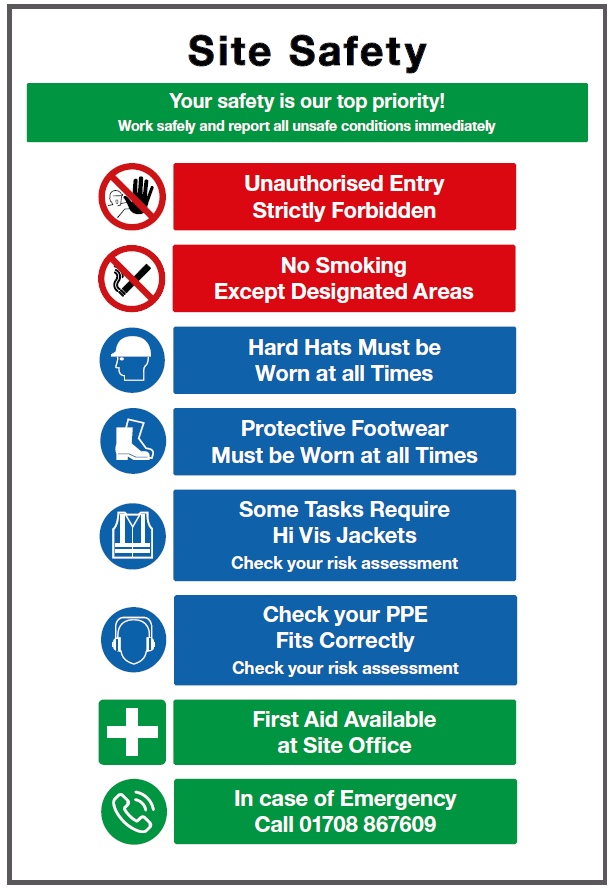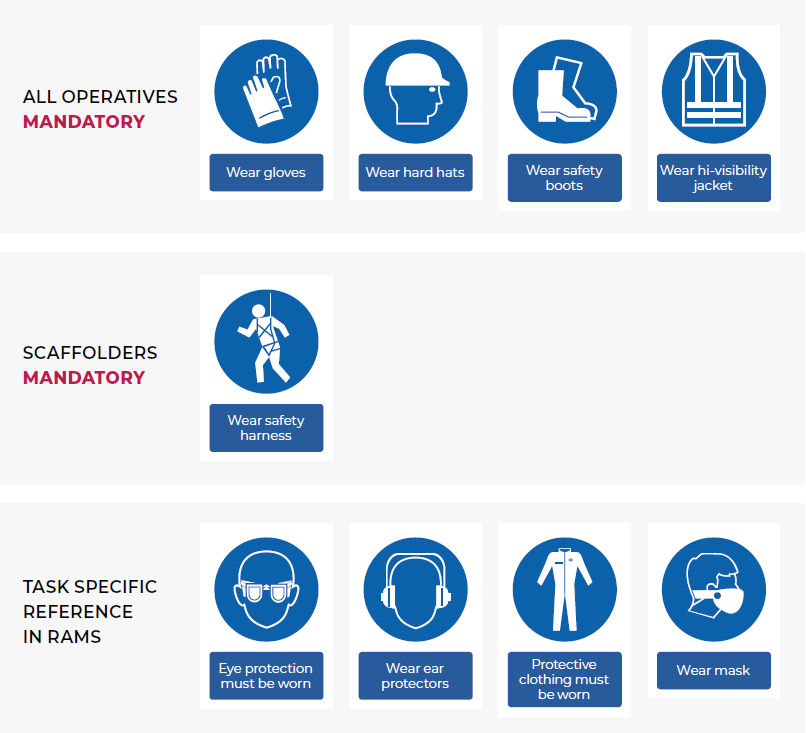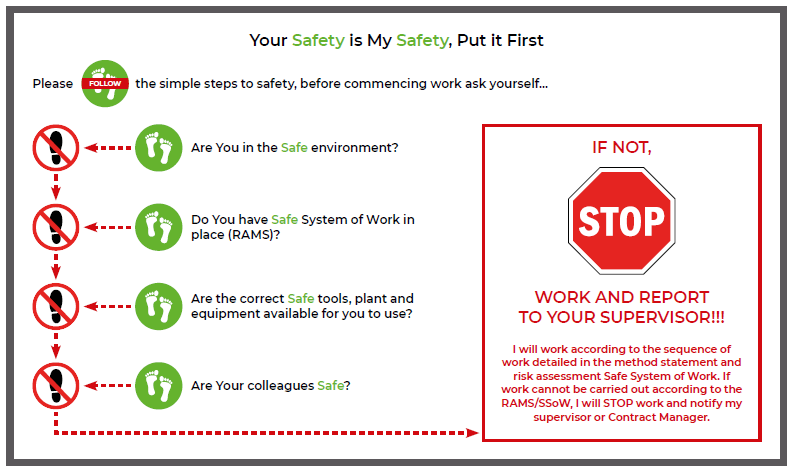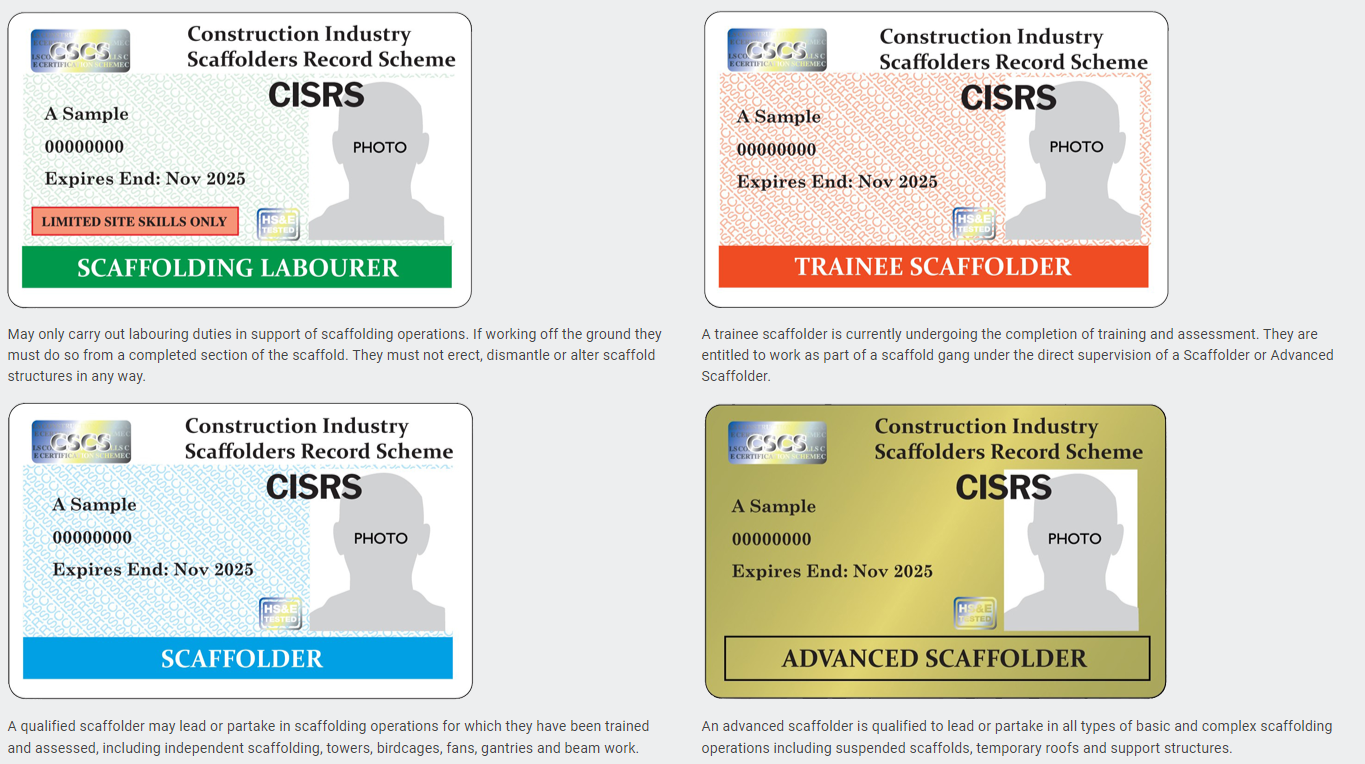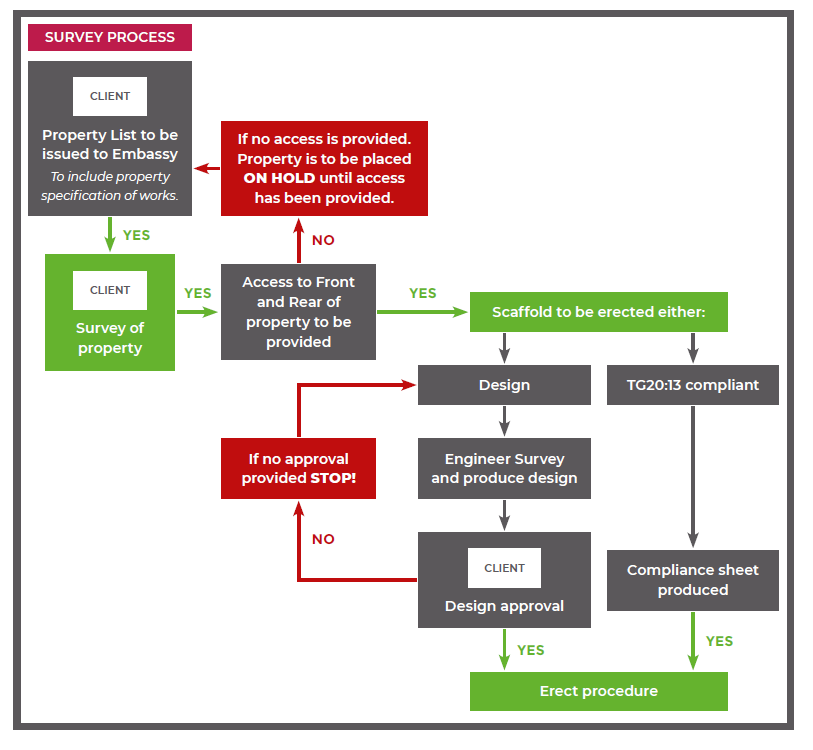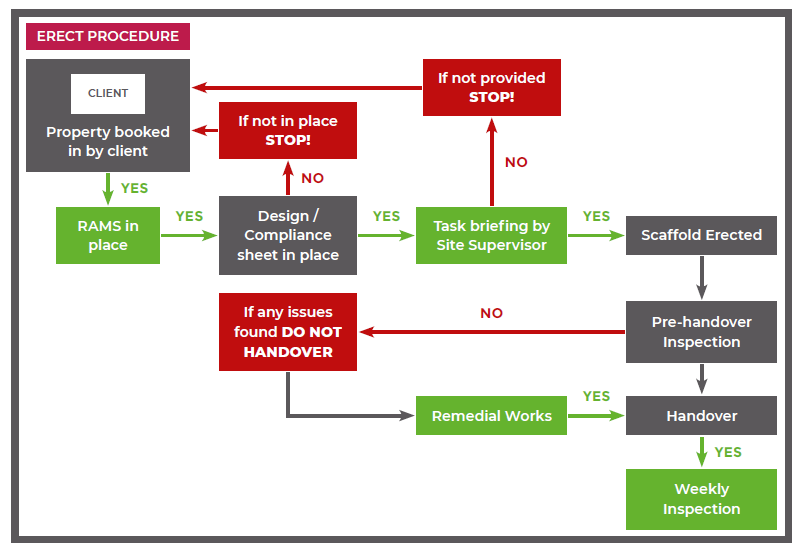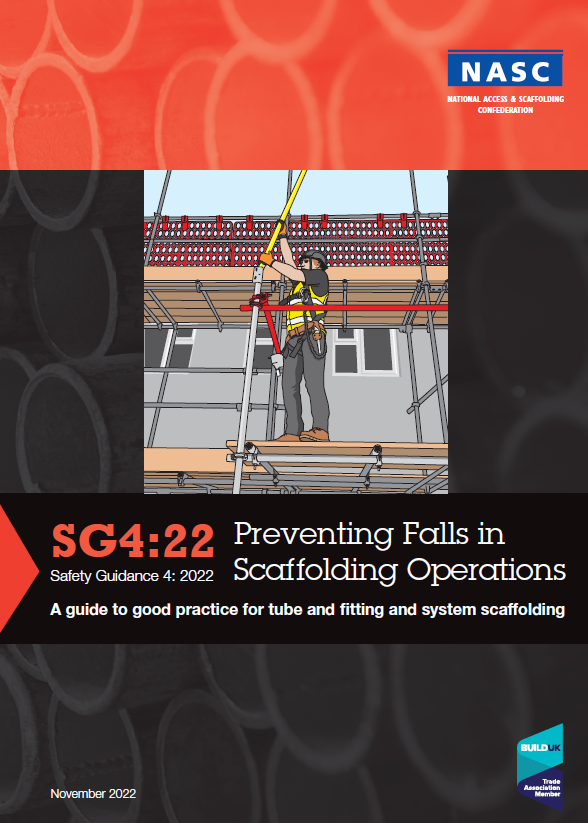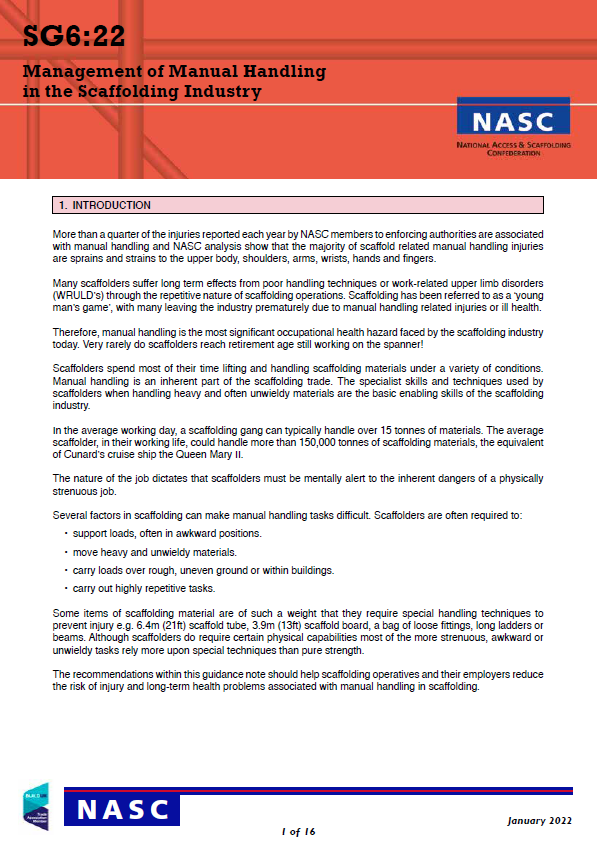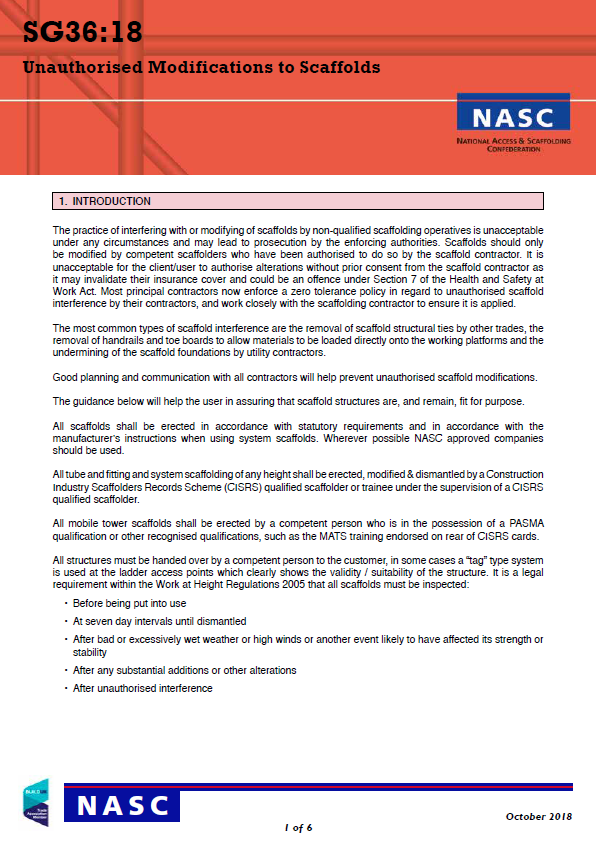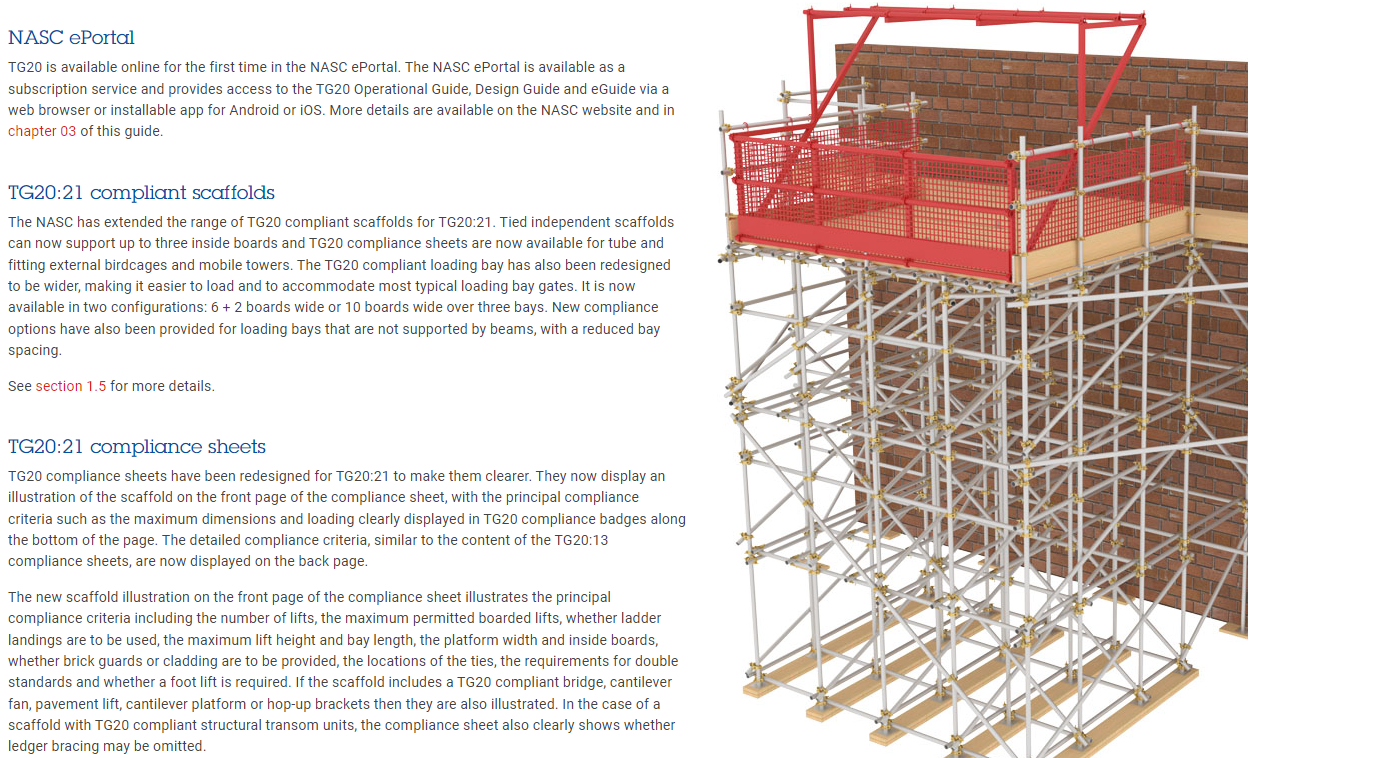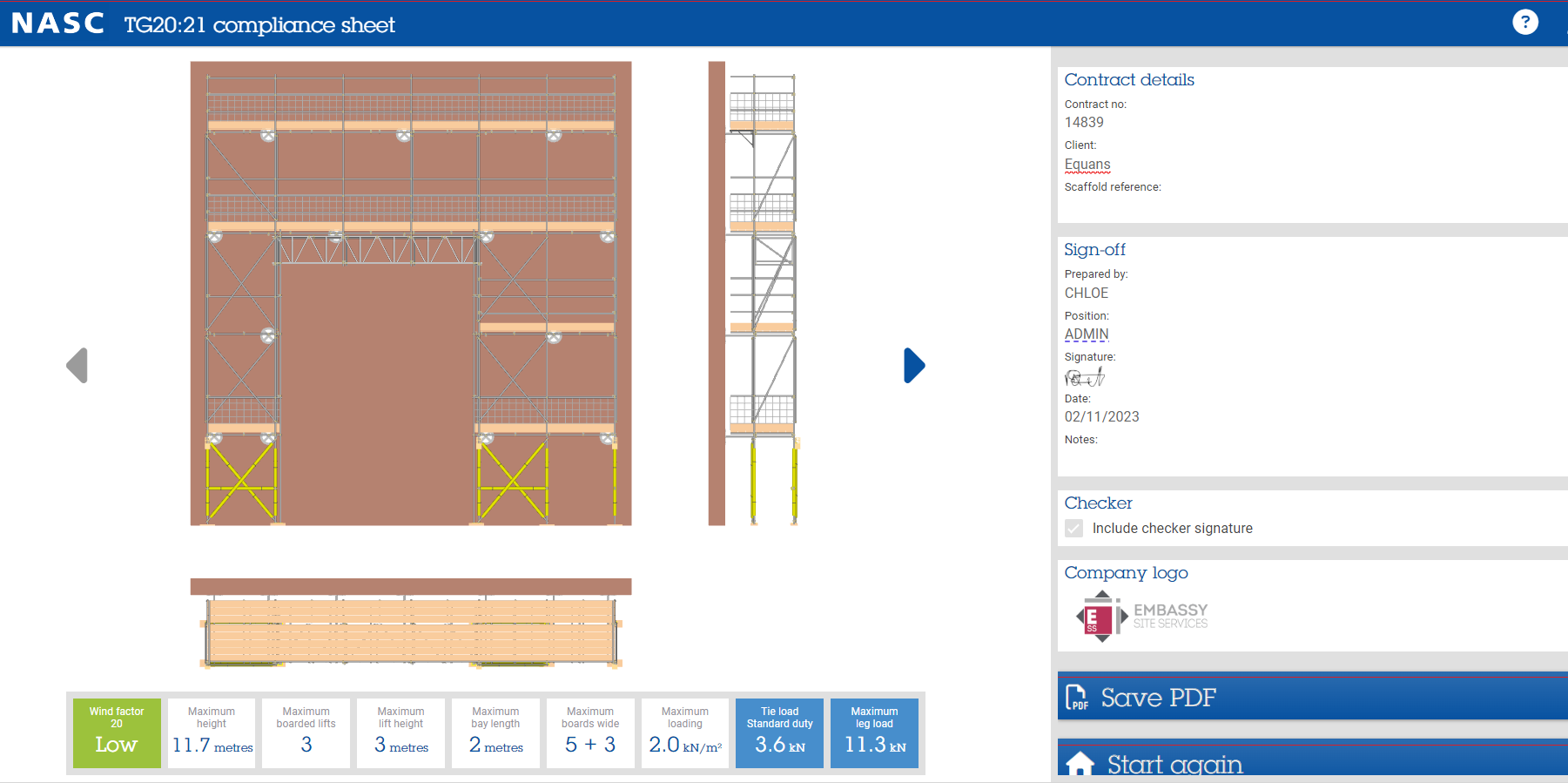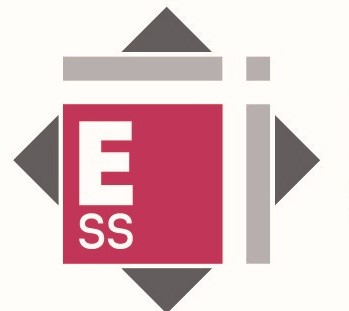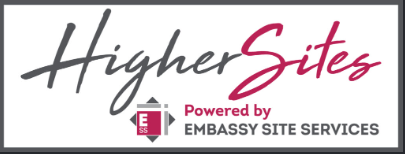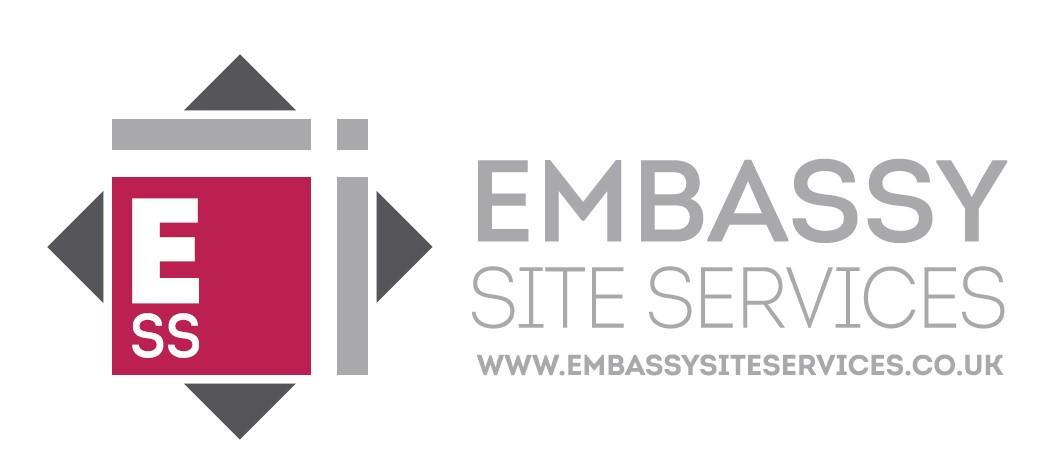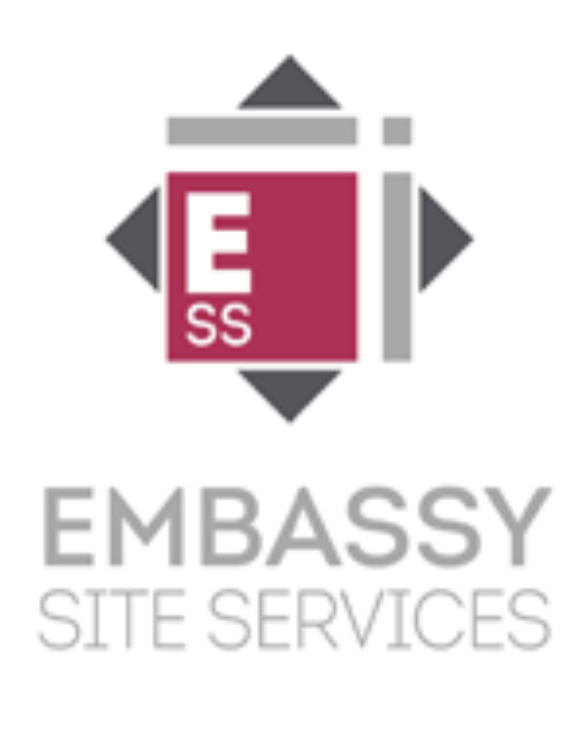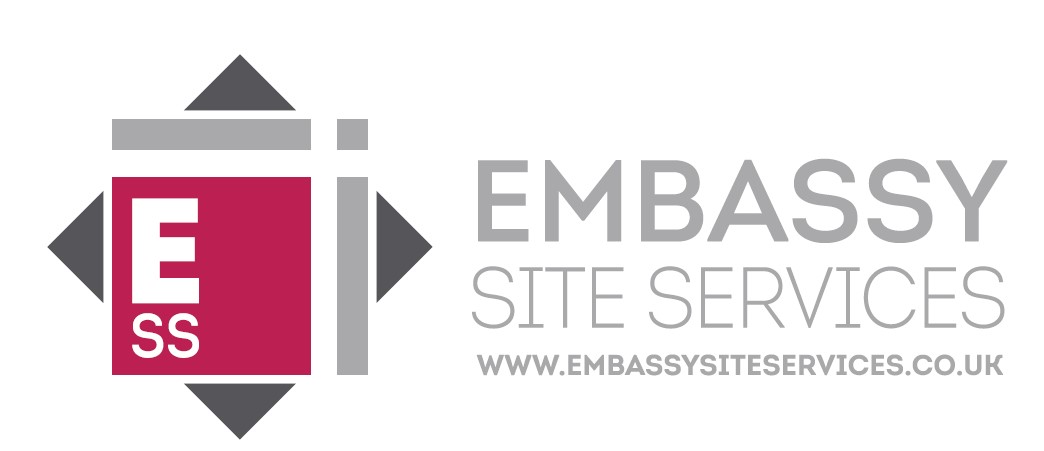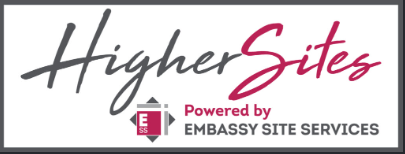Title Page
-
Site conducted
-
Training Location
-
Date
-
CSCS/CISRS Skill Set
- Advanced Scaffolder
- Part 2 Scaffolder
- Part 1 Trainee Scaffolder
- CSCS COTS Scaffolding Labour
- CSCS Labour
- CSCS Gold Card
- CSCS Blue Card
- CSCS Red Card
- CSCS Green Card
- CSCS Black Card
- Other
- Driver
- Roofer
- Manager /Supervisor
-
Occupation
- Advanced Scaffolder
- Part 2 Scaffolder
- Part 1 Trainee Scaffolder
- CSCS COTS Scaffolding Labour
- CSCS Labour
- CSCS Gold Card
- CSCS Blue Card
- CSCS Red Card
- CSCS Green Card
- CSCS Black Card
- Other
- Driver
- Roofer
- Manager /Supervisor
-
Full Name and Photo
Training Content
-
Embassy Site Services overall Health, Safety, Environmental and Quality Policies- What we do and what expect employees to do
-
Health & Safety Policy At Embassy, we believe that every job is worth doing and doing it safely. We believe that with our experience, resources and talent we can provide our customers with exceptional service and provide safe methods of working. Our objectives, like all other objectives, should be SMART: Specific, Measurable, Achievable, Realistic and Timebound. Our objectives are to: • Provide adequate control of the health and safety risks arising from all our work activities • Consult with our employees on matters affecting their health and safety • Provide and maintain safe working conditions, plant and equipment • Ensure safe handling and use of substances • Provide information, instruction and supervision for employees, subcontractors, the public, neighbours and our customers • Ensure all employees are competent to safely do their tasks and to give them adequate training • Prevent accidents and cases of work-related ill-health • Review and revise this policy at regular intervals • It is also the duty of all employees to read understand and participate in implementing and maintaining this policy to ensure the health safety & welfare of themselves and others who may be affected by their actions The owners, directors and all staff of Embassy are committed to complying with all applicable legal requirements and those of our customers and to establishing, maintaining, constantly review and improving our health and safety management system (ISO 45001) and keep our commitment to our customers, the public, neighbours, staff and suppliers. Copies of our policy are made available to all our customers and members of staff.
-
Environmental Management Policy At the Embassy, we believe that every job is worth doing and doing it well. We believe that with our experience, resources and talent we provide our customers with exceptional service and can and will reduce our impact on the environment. Our environmental objectives, like all other objectives, should be SMART: Specific, Measurable, Achievable, Realistic and Timebound. To reduce our environmental impact our objectives are: Within 12 months reduce waste to landfill by 10% Reduce the amount of waste produced Reduce the consumption of raw materials, water and fuels Use recyclable and renewable materials in place of virgin products where possible Directors and staff will meet our objectives by: Meeting all our legal, moral and compliance obligations to our customers, ISO 14001, FSC®, PEFC Constantly reviewing and improving what we do Looking after our community The owners, directors and all staff of the Embassy are committed to establishing, maintaining, constantly review and improving our environmental management system and keeping our promises to our customers, neighbours, staff and suppliers. Copies of our environmental policy are made available to all our customers and members of staff.
-
Quality Management Policy At the Embassy, we believe that every job is worth doing and doing it well. We believe that with our experience, resources and talent we provide our customers with exceptional service. To ensure customer satisfaction our quality objectives are: • Within 12 months improve customer satisfaction by 90% Directors and staff will meet our objectives by being caring, dedicated and accountable are not words you often hear associated together in the construction industry, but at Embassy, these values form part of our business value of: • Trustworthy- Giving honest answers • Quality- Constantly reviewing and improving what we do • Experience- Complying with all legal and statutory requirements • Flexibility- Not making excuses • Dedication- Informing and looking after our staff and growing our talent. • Collaboration- Sorting out issues quickly and making sure they don’t occur again • Caring- Informing and looking after our staff and growing our talent. • Value for money- Competitive pricing, reliable service The owners, directors and all staff of the Embassy are committed to establishing, maintaining, constantly review and improving our quality management system and keeping our promises to our customers, staff and suppliers. Copies of our quality policy are made available to all our customers and members of staff.
-
Lines of communication- Who to report to/Who is who in the organisation
-
Senior SHEQ Advisor: Sebastian Lik -Mob: 077193119116 Scaffolding General Manager: Anthony McDonnell- Mob: 07432077036 Contracts Manager(s): Mick Stockinger- Mob: 07973135129 Lennie Mullane- Mob: 07926127891 Transport Manager: Liam Brennan- Mob: 07395360921 Advanced Scaffold Safety Inspector(s) Michael Lake- Mob: 07939438382 Yard Manager: Kenny Lea-Cox- Mob:07831144105
-
undefined
-
Employer & Employee Responsibilities
-
As an employer, the five primary responsibilities are: We must conduct thorough risk assessments, document and implement all health and safety processes and make sure they are communicated and adopted by all staff. We must continue to oversee all processes and check that the measures remain in place. We must also ensure that policies are updated when government guidance changes. We are responsible for all training and management of records, including those related to incidents. We must also appoint a ‘competent person’ with health and safety responsibilities and ensure they receive all the appropriate training and support.
-
Your responsibilities Your most important responsibilities as an employee are: To take reasonable care of your own health and safety. If possible to avoid wearing jewellery or loose clothing if operating machinery If you have long hair, or wear a headscarf, make sure it's tucked out of the way as it could get caught in machinery. To take reasonable care not to put other people - fellow employees and members of the public - at risk by what you do or don't do in the course of your work. To co-operate with your employer, making sure you get proper training and you understand and follow the company's health and safety policies. Not to interfere with or misuse anything that's been provided for your health, safety or welfare To report any injuries, strains or illnesses you suffer as a result of doing your job, your employer may need to change the way you work. To tell your employer if something happens that might affect your ability to work, like becoming pregnant or suffering an injury - because your employer has legal responsibility for your health and safety, they may need to suspend you while they find a solution to the issue or problem, but you will normally be paid if this happens. If you drive or operate machinery, you have a responsibility to tell your employer if you take medication that makes you drowsy. if you have, they should temporarily move you to another job if they have one for you to do Safe manual work Accidents in the workplace Suspension from work on medical/ health and safety grounds.
-
undefined
-
Emergency Procedures i.e. Fire, Environmental- The emergency procedure is a plan of actions to be conducted in a certain order or manner, in response to an emergency event. ... Procedure carried out during a fire, serious accident in the workplace where the operatives are evacuated via the nearest exit as the emergency services are called.
-
Orientation to any new job site, even if temporary, should always include the following information: Means of Communication Location of emergency exits Location of first aid supplies or the procedures to call for an attendant Location of fire extinguishers Evacuation procedures and Muster Pint Stations Any hazards present on the site i.e. Asbestos , Work at Height
-
LOLER/PUWER how these regulations affect our work
-
The Lifting Operations and Lifting Equipment Regulations 1998 ( LOLER 1998) requires lifting equipment to be thoroughly examined regularly, usually at 12-monthly intervals for lifting goods and 6-monthly for lifting people. Much like PUWER regulations, it requires equipment to be safe to use, and inspected by a competent person, with records kept.
-
Site Specific Safety Rules
-
Simple Site Safety Rules 1. Do not start work without a site safety induction- Site Safety Inductions are a legal requirement on every construction site you work on. Each site has its unique hazards and works operations. 2. Do not put yourself or others at risk- Actions speak louder than words. Especially on building sites where one wrong move could put you in harm's way. 3. Always Wear your Personal Protective Equipment and Personal Fall Protective Equipment 4. Fallow site safety signage and procedure- Fellow site safety signs and procedures. These should be explained to you in your induction 5. Never work in an unsafe manner or areas- Make sure that your work area is safe. Know what is happening around you. 6. Report all Accidents/Incidents and Near Misses- If you notice a problem, don't ignore it, report it to your line manager/supervisor immediately 7. Never tamper with equipment- If something not working, or doesn't look right, follow rule 6 and report it 8. Use the right tools and equipment- One tool does not fit all. Using the correct tool for the job will get it done quicker, and most importantly, safer. Visually check equipment is in good condition and safe to use before you start 9. Keep a tidy site- Remember to keep your work area tidy throughout your shift to reduce the number of slip and trip hazards. Pay particular attention to areas such as access and escape routes 10. If in doubt, ask- Unsure what to do? or how to do something safely? or you think something is wrong? Stop work and ask your line supervisor or manager. Mistakes on building sites can cost lives, don't let it be yours.
-
Site Safety
-
Protection of the public
-
One way you can ensure public safety during construction work is by managing site access. You must define site boundaries clearly and physically with suitable fencing. A fence can help to prevent people from entering the site and prevent particular objects from escaping.
-
Manual Handling Operations
-
Planning for Manual Handling Operations ESS operatives must consider manual handling operations as an integral part of the planning process. Managers and supervisors must consider manual handling as part of the initial risk assessment process when they are surveying and considering the scope of the job. 1. Access to the site for vehicle and materials 2. Loading and Unloading Requirements 3. Storage of Materials onsite and at the workplace 4. The use of shared mechanical handling equipment e.g. forklift trucks, Hiab, Cranes, Hoist etc. 5. Are the ground conditions suitable for manual handling of materials? 6. Manual Handling Aids e.g., lifting fitting bags, Gin Wheel, Trolleys, trucks and wheelbarrows etc. 7. Adequate Training, Information, and Instruction e.g. Kinetic Lifting Techniques
-
Preventing falls from height/people/objects
-
Exclusion Zones Ideally, the public should be excluded from the area of work and a sufficient surrounding area, with barriers installed to prevent access to hazardous areas (which can be combined with work in quiet times, subject to noise restrictions
-
Prevision and use of personal protective equipment - Safety Hamlets, Safety Boots, Vi-Vis Vest, Gloves and Harness and Lanyard (Competent Operatives/Scaffolders )
-
Employers should provide appropriate personal protective equipment (PPE) and training in its usage to their employees wherever there is a risk to health and safety. Whenever there are risks to health and safety that cannot be adequately controlled by other ways, the Personal Protective Equipment at Work Regulations requires PPE to be worn. What is PPE? PPE is equipment that will protect the user against health and safety risks at work.
-
Personal Protective Equipment Requirements
-
Reporting of accidents and what to do in the event of an injury/ accident/incident
-
How do I report an Accident at Work Step 1: Check there is no immediate risk of danger. Immediately after the incident has occurred you must assess the accident area. Step 2: Ensure that the colleague receives the appropriate medical assistance as necessary. Step 3: Report to a manager or supervisor. This is the final step that can be carried out if you are a general employee. Step 4: Manager/Supervisor record the incident in the company’s log.
-
Your Safety is My Safety, Put it First
-
Reporting of Near Misses-What is Near Miss?
-
Near miss definition An unplanned event that did not result in injury, illness or damage – but had the potential to do so.
-
Task Risk Assessments and Method Statements- Site Based/Generic
-
Risk Assessment and Method Statement (RAMS) are designed to ensure everyone who can be affected by the activity is considered and hazards are eliminated at source or if this is not possible the risks should be controlled and reduced as far as is reasonably practicable to an acceptable level, to ensure accidents and incidents do not occur.
-
Hazard Identification and Safe System of Work Procedures
-
Why is it necessary to identify hazards in the workplace? Identifying and reporting hazards in the workplace is one of the most powerful ways in which workers and companies can improve workplace safety. Many workplace injuries and incidents are a result of unidentified hazards or a lack of action on controlling the risk associated with a specific hazard. 1 - Identify hazards -Identify and find things that have the potential to cause harm, these can include: Biological hazards - Bacteria, viruses, animals, other humans Chemical hazards - Hazards stemming from any hazardous chemical Ergonomic hazards - Repetitive movements, incorrect posture, incorrect set up of work environment Physical hazards - Temperature extremes, pressure extremes, noise, vibrations Psychosocial hazards - Violence, stress Safety hazards - Equipment breakdowns, slip and trip hazards, electrical hazards etc. 2 - Assess risks -Understand the nature of the harm caused by the above hazard, including how severe the harm would be and the likelihood of its occurrence. 3 - Control risks -Implement control measures that reduce the likelihood and severity of the risk, practically and feasibly. Step 4 - Review control measures -Watch and review the control measures over time, to understand how they are performing and whether or not they need to be amended or changed As you can see from the above sequence of managing workplace health and safety, to identify risk is to take the first step in implementing new and improved safety practices which lead to better workplace safety.
-
Work Safe Procedure
-
Competency and Training Records (CSCS,CISRS,CPCS,MEWP etc)
-
A competent person is designated by a company to ensure that the company's health and safety responsibilities are being met. This may be a legal obligation required of the company, to ensure that the business understands, and can act on, the health and safety risks
-
Competency and Training
National Access & Scaffolding Confederation - Safety and Technical Guidance (SG/TG)
-
ESS Scaffold Survey Procedure
-
Survey Procedure
-
ESS Scaffold Erect Procedure
-
Erect Procedure
-
NASC Safety Guidance 4:22
-
(SG4 Preventing Falls in Scaffolding Operations)
-
NASC Safety Guidance 6
-
(SG6 Manual Handling in Scaffolding Industry)
-
NASC Safety Guidance 34:17
-
(SG34 Guidance on protection of the public)
-
NASC Safety Guidance 36:18
-
(SG36 Unauthorised Modifications to Scaffolds)
-
NASC Technical Guidance 4-17
-
(TG4 Anchorage Systems for Scaffolding)
-
NASC Technical Guidance 20:21 -
-
(TG 20:21 Operational Guide)
-
NASC Technical Guidance 20:21-
-
(TG20:21 Scaffold Compliance Sheet)
Sign Off
-
Full Name - I confirm that I have received company induction training. While at work, I am obligated to adhere to Embassy Site Services SHEQ policies and procedures.
-
ESS SHEQ Training Completed
-
SHEQ Induction Training conducted by Full Name & Position






